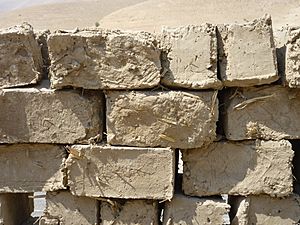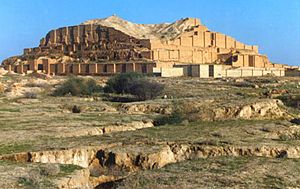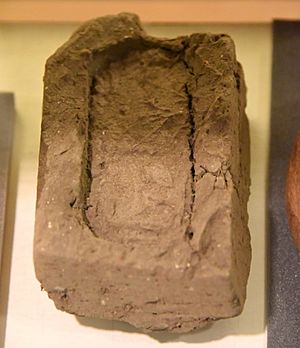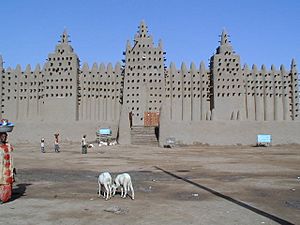Mudbrick facts for kids
A mudbrick is a special kind of brick. It's made from a mix of loam (a type of soil), mud, sand, and water. People often add things like rice husks or straw to help the bricks stick together better.
In places that are warm and don't have much wood for fires, mudbricks are a great building material. This is because they can be dried by the sun instead of needing a hot oven (called a kiln). Sometimes, builders would put stronger, fired bricks on top of mudbrick walls or cover them with stucco (a type of plaster) to make them last even longer.


Contents
Mudbricks in Ancient Times
Mudbricks have been used for thousands of years! They were very important for building in many ancient civilizations.
Early Builders in Asia
One of the earliest places where people used mudbricks was Mehrgarh in South Asia. People there built and lived in mudbrick houses as far back as 7000 to 3300 BC. That's a really long time ago!
Mudbricks were also a big part of the ancient Indus Valley civilization. They were found at more than 15 sites from around 3000 BC. Later, in the Mature Harappan period, people started using fired mudbricks too, which are stronger.
Mudbricks in Mesopotamia and Egypt
The people of Mesopotamia also used sun-dried bricks to build their cities. These bricks often had a flat bottom and a curved top.
In Ancient Egypt, workers would collect mud from the Nile river. They would dig a pit, pour the mud in, and then stomp on it. They added straw to the mud to make it stronger and easier to shape into bricks.
Minoan Crete and Roman Influence
Even on the island of Crete, where the Minoan civilization lived, archaeologists have found evidence of sun-dried bricks being used before 3400 BC.
Mudbricks were also used in Ancient Egypt before the Romans arrived. Their use became even more common when the Romans started to have an influence in the area.
Adobe Construction
In areas that were influenced by Spain, like parts of the Americas, mudbrick building is called adobe. Over time, adobe became a complete way of building, including how to protect walls, make flat roofs, and add finishes. Today, when people talk about "adobe style," they often mean buildings that look like traditional adobe, even if they aren't made with mudbricks.
Banco: A Special Mudbrick
The Great Mosque of Djenné in Mali is an amazing example of mudbrick building. It's the largest mudbrick structure in the entire world!
Many buildings in the Sahel region of Africa are made with a special kind of mudbrick called Banco. Banco is made from a mix of mud and grain husks. This mixture is left to ferment (like making bread dough). Then, it's either shaped into bricks or spread onto surfaces like a thick plaster. This special plaster needs to be put on again every year to keep the buildings strong.
Mudbrick Buildings Around the World
Mudbricks are still used today in many parts of the world. They are a great way to build homes and other structures, especially in places where other building materials are expensive or hard to find.
-
Making mudbricks in Niger in 2007.
-
Mudbricks are still used in the Romania Danube River Delta.
-
Traditional painted mudbrick buildings in the "Old Town" of Zinder, Niger.
-
Tall mudbrick buildings in Shibam, Yemen.
-
Making mudbricks near Cooktown, Australia.









